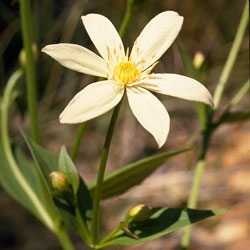Clematis gentianoides
 |
 |
Bushy Clematis
Clematis is a member of the Ranunculaceae family, which includes anemones, peonies, buttercups and aquilegias. This large genus consists of over 200 species, found mainly in the temperate zones of the northern hemisphere. Most Clematis are longed lived and deciduous, but there are also evergreen varieties such as Clematis gentianoides a small perennial scrambling shrub.
 Clematis
gentianoides is one of six species found in Australia. It is the only non-climbing
species endemic to Tasmania, where it is widely distributed and particularly
abundant on poor soils and well-drained slopes of north-eastern Tasmania. Outside
of it’s native habitat, Clematis gentianoides will grow successfully
from Victoria to as far north as Sydney and can withstand frosts of up to -10°
C (14° F), provided the plants are not too wet during winter.
Clematis
gentianoides is one of six species found in Australia. It is the only non-climbing
species endemic to Tasmania, where it is widely distributed and particularly
abundant on poor soils and well-drained slopes of north-eastern Tasmania. Outside
of it’s native habitat, Clematis gentianoides will grow successfully
from Victoria to as far north as Sydney and can withstand frosts of up to -10°
C (14° F), provided the plants are not too wet during winter.
The leaves of this species could best be described as thick, green and glabrous, with either entire or serrate margins. They are usually simple, ovate-lanceolate in shape, 2-8cm long with either an acute or obtuse tip. At the leaf base, flat petioles clasp ribbed stems. These stems are commonly 40-60cm high and sometimes trailing.
A unique characteristic of this species, are the rhizomes, which produce flowering branches, 15-50cm high from Spring to Summer. They bear prominent, white solitary flowers found on axilliary and terminal inflorescences. The floral arrangement consists of four to eight tepals, which attract night flying pollinators. Plants are dioecious, that is having male and female flowers born on separate plants. The males are characterised by narrow-linear anthers with a connective prolonged into a short terminal appendage. The female flowers are easily identified by the attractive styles growing off the achenes. These persist to form curved feathery appendages on tightly clustered fruit 2-3cm long
Unlike other Clematis this species can survive in poor soils provided they are free draining, this plant does not tolerate waterlogged soils. If planting in heavy soils, sand or shell grit should be dug in and the soil beds raised to increase drainage. However if conditions are clearly not favorable, plants can be grown successfully in a pot large enough to allow room for rhizomes to spread. Wit pots use a course free draining potting mix, which is loamy and high in humus content.
In the garden C. gentianoides grows well in protected sites, from filtered to full sun, and will benefit from mulch around the roots to protect the rhizomes. If soils are low in nutrients, it is advisable to use a nutrient-rich mulch (i.e. a high leaf content). Landscaping materials such as pebbles or rocks can also be used to filter rainwater to the plant. This will simulate the plants natural growing conditions and reduce the maintenance required. Although in some cases, plants may need additional watering and fertilizing in summertime, to promote vegetative growth and stimulate flowering. During winter-spring the plants may be pruned to ensure a bountiful display of starry white flowers in the summer. Prune back to a strong pair of buds up to 50cm above the surface.
The off-cuts may then be used to take cuttings of the plants, which should be 10cm long with at least two nodes. Cuttings will strike in approximately 4-5 weeks and require temperatures of 20° - 25° C (68° - 77° F), preferably grown in a hot house. Alternatively propagation techniques such as laying and division of rhizomes produce excellent results. The plant can also be propagated from seed, which must be collected and sown when fresh. Seeds will germinate after 2-12 months depending on the ripeness. Often they will germinate with frosts, which may possibly be a trigger for germination.
This is one plant that will produce spectacular results if you are willing to invest a little time and effort.
Text by Hayley Woodward (2004 Student Botanical Intern)
Derivation of the name: Clematis gentianoidesClematis – is derived from the Greek word ‘clema’, describing the climbing tendril characteristic of this genus. gentianoides – oides, Greek derivative, means ‘like’, referring to the leaves of this Clematis resembling those found on gentians.
|
References
Wilson. G. ‘The Clematis Genus’ Timber Press Inc. 2000, Portland Oregon
Jones.DL & Gray B. ‘Climbing Plants in Australia’ Reed Books Pty Ltd, French’s Forest NSW 2086
Kirkpatrick. J. ‘Alpine Tasmania – Illustrated Guide to Flora and Vegetation’ Oxford.
Curtis, W.M. & Morris. D.I. ‘ The Students Flora’ St Davids park Publication 1994 - Part 4B, Hobart Tasmania
Anon. ‘South West Tasmania – A Natural History & Visitors Guide’ Published by Heritage Books, Hobart Tasmania, Printed by Hong Kong Dai Nippon Printing CO.
The Society for Growing Australian Plants. ‘ Australian Plants’ no. 93 issue, volume 12 – 13 (p.155), Henry Lawson edn., Picnic Point, NSW 2213
Ralph.M ‘Growing Australian Natives from Seed for Revegetation, Tree Planting and Direct Seeding’ Ralph Bushland Horticulture, Fitzroy Australia.
Stewart. A ‘ Let’s Propagate – A Plant Propagation Manual for Australia’ published ABC Books Australian Broadcasting Corporation 1999, printed by Australian Print Group, Maryborough VIC
Buchanan A.M . " The Tasmania Collecting Localities of Ronald Gunn & Joseph Mulligan’ Occasional Publication no.1, Tasmanian Herbarium, Hobart Tasmania.
![An Australian Government Initiative [logo]](/images/austgovt_brown_90px.gif)

